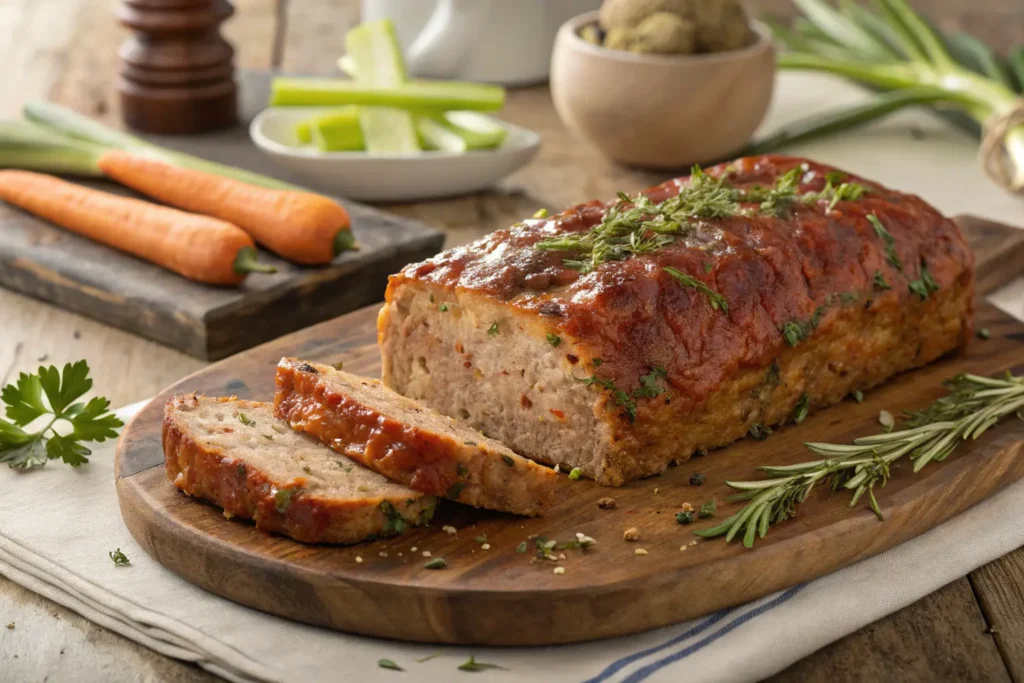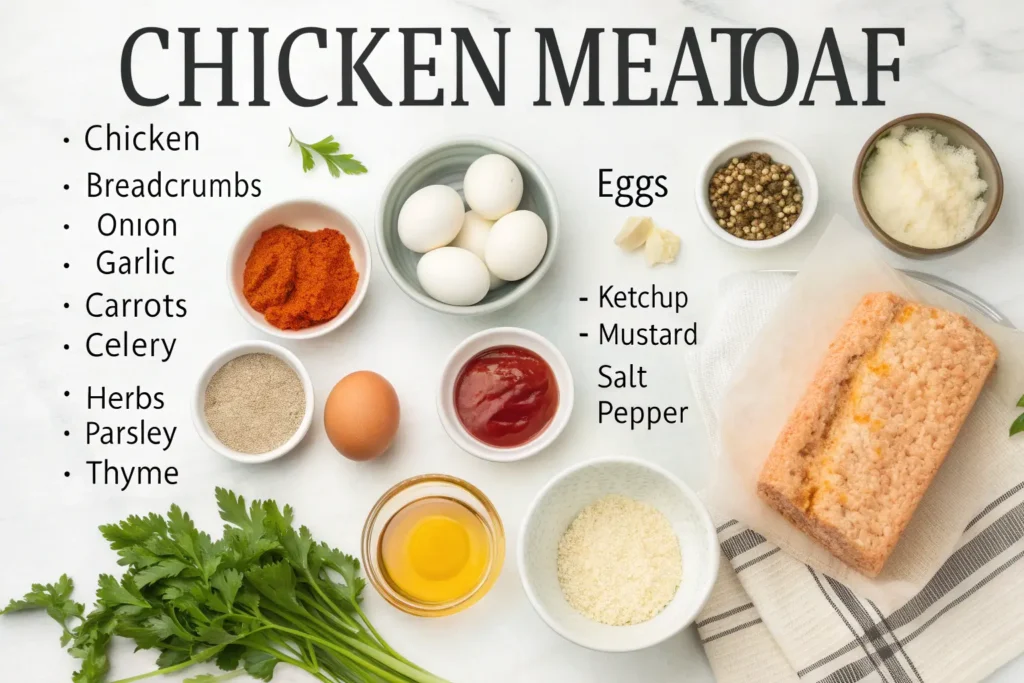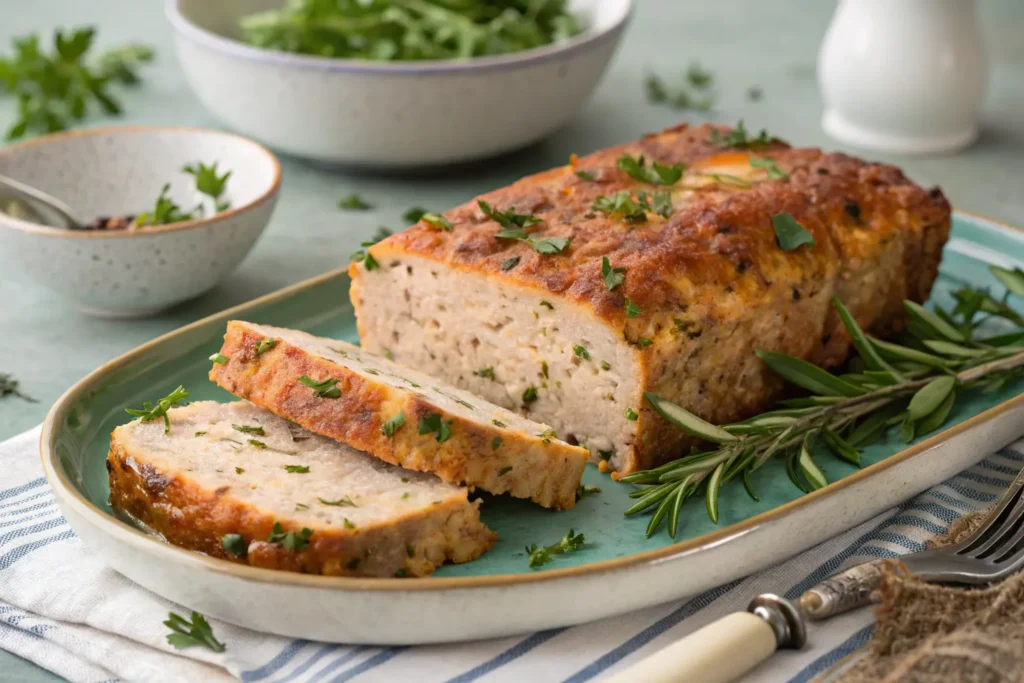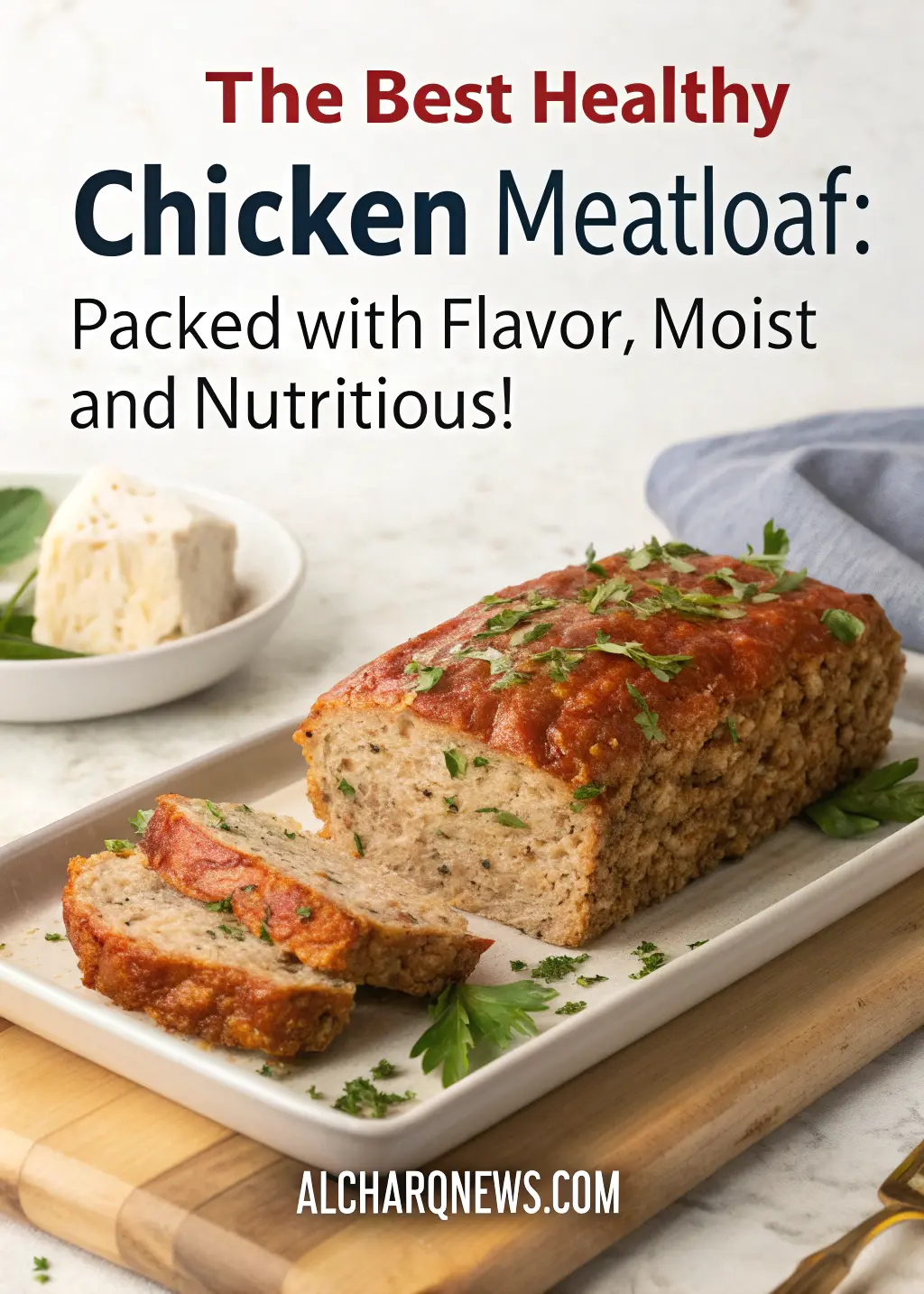Introduction: More Than Just Another Chicken Meatloaf Recipe
Do you remember that comforting aroma wafting through your grandmother’s kitchen? That unmistakable scent of meatloaf slowly baking, promising a satisfying dinner ahead? For many households, traditional meatloaf represents the epitome of comfort food, yet often carries a hefty nutritional price tag that doesn’t align with contemporary wellness goals.
Perhaps you’ve attempted lighter versions before, only to be disappointed by dry, flavorless results that left you craving the original. Through countless kitchen experiments and relentless tweaking, I’ve discovered the perfect balance – a chicken meatloaf that delivers exceptional moisture, robust flavor, and impressive nutritional benefits. This isn’t merely a compromise you’ll endure; this recipe will quickly become your family’s new favorite while supporting healthier eating habits.
Table of contents

Why Chicken Meatloaf Deserves a Place in Your Meal Rotation
Transforming the classic comfort dish into a nutritional powerhouse offers numerous advantages. By substituting chicken for traditional beef, you’ll immediately reduce saturated fat content while maintaining impressive protein levels. Unlike many “healthy” alternatives that sacrifice satisfaction, this recipe prioritizes both nutrition and flavor.
Your weekly meal planning will benefit tremendously from this versatile dish. Prepare it on Sunday for delicious leftovers throughout the week, serve it confidently at family gatherings, or customize it to accommodate various dietary preferences. Most importantly, this recipe solves the notorious “dry chicken” dilemma through strategic ingredient combinations and cooking techniques that guarantee exceptional moisture retention.
The Science Behind Perfect Chicken Meatloaf
Why Traditional Meatloaf Recipes Don’t Work with Chicken
Understanding the fundamental differences between beef and chicken explains why simple protein substitution typically fails. Chicken contains significantly less intramuscular fat (marbling) than beef, which naturally provides moisture and flavor during cooking. Additionally, chicken protein structures respond differently to heat, often resulting in tougher textures when using conventional cooking methods.
Most classic recipes rely heavily on beef’s natural fat content for moisture and flavor. When chickens enters the equation without compensatory adjustments, disappointment inevitably follows – typically manifesting as dry, crumbly texture and bland taste profiles.
Key Techniques for Moist, Flavorful Chicken Meatloaf
Achieving restaurant-quality results requires several crucial interventions. First, selecting appropriate binding ingredients creates the structural foundation while contributing moisture. The strategic incorporation of vegetables serves dual purposes – enhancing nutritional content while releasing moisture during cooking.
Flavor amplification becomes particularly important when working with chicken’s milder profile. By incorporating umami-rich ingredients like tomato paste and Worcestershire sauce, you’ll develop depth comparable to beef versions without additional fat. Precise temperature control during cooking prevents moisture loss, while allowing proper resting time afterward enables internal redistribution of juices before slicing.
Nutritional Breakdown: Why This Chicken Meatloaf is a Powerhouse
When comparing nutritional profiles, the advantages become immediately apparent. A standard serving of traditional beef meatloaf typically contains approximately 12-15 grams of saturated fat, while this chicken version delivers just 3-4 grams – a reduction exceeding 70% without sacrificing protein content, which remains impressive at approximately 25 grams per serving.
The hidden vegetable integration – including carrots, zucchini, and onions – contributes significant fiber, vitamins A and C, and various phytonutrients absent from conventional recipes. Total calorie content averages 250-300 per serving, roughly half that of beef alternatives, making this recipe compatible with various nutritional approaches including low-carb, moderate-protein, and reduced-calorie eating plans.
Essential Ingredients for the Perfect Healthy Chicken Meatloaf
The Base Ingredients
| Ingredient | Amount | Key Benefit |
|---|---|---|
| Ground chicken breast | 1 pound | Lean protein source, low in saturated fat |
| Ground chicken thigh | ½ pound | Adds moisture and flavor while still healthier than beef |
| Rolled oats or almond flour | ½ cup | Gluten-free binding agent with added fiber |
| Eggs | 2 large | Natural binding and moisture |
| Onion | 1 medium, finely diced | Flavor and moisture |
| Carrots | 2 medium, grated | Hidden vegetables for nutrients and moisture |
| Zucchini | 1 small, grated | Extra moisture and nutrients |
| Garlic | 3 cloves, minced | Flavor and health benefits |
The Flavor Boosters
| Ingredient | Amount | Key Benefit |
|---|---|---|
| Fresh herbs (parsley, thyme, rosemary) | ¼ cup, chopped | Natural flavor without added sodium |
| Tomato paste | 2 tablespoons | Umami richness and moisture |
| Worcestershire sauce | 1 tablespoon | Depth of flavor |
| Dijon mustard | 2 teaspoons | Tangy flavor profile |
| Smoked paprika | 1 teaspoon | Smokiness without bacon |
| Salt and pepper | To taste | Basic seasoning |
For the Glaze (Optional but Recommended)
| Ingredient | Amount | Key Benefit |
|---|---|---|
| Tomato paste | 3 tablespoons | Base for glaze |
| Maple syrup or honey | 1 tablespoon | Natural sweetener |
| Apple cider vinegar | 1 tablespoon | Tangy balance |
| Garlic powder | ½ teaspoon | Additional flavor layer |
| Smoked paprika | ¼ teaspoon | Color and smoky notes |
Step-by-Step Process for Foolproof Chicken Meatloaf
Preparation Phase
Proper vegetable preparation dramatically influences your final result. Rather than roughly chopping, take time to finely dice onions and thoroughly grate carrots and zucchini. This attention to detail ensures even distribution throughout the mixture while making vegetables virtually undetectable for picky eaters.
When combining ingredients, use a gentle touch. Overworking poultry mixtures develops tough proteins, resulting in dense texture. Instead, mix components until barely combined, using clean hands for most efficient incorporation. Before committing to the entire batch, test seasoning by cooking a small portion in a skillet – this simple step allows flavor adjustments before proceeding.
Form your mixture into a slightly rounded loaf shape rather than packing tightly into a traditional loaf pan. This approach maximizes surface area for delicious caramelization while ensuring even cooking throughout.
Cooking Method
Line your baking surface with parchment paper to prevent sticking and facilitate easy cleanup. Bake initially at 375°F for approximately 35-40 minutes or until internal temperature reaches 155°F. At this point, apply your prepared glaze and return to the oven for an additional 10-15 minutes until internal temperature reaches 165°F – the food safety threshold for poultry.
Visual indicators complement temperature readings – look for slightly browned edges and clear (not pink) juices. Once removed from the oven, allow your masterpiece to rest for 10-15 minutes. This crucial period enables protein fibers to reabsorb moisture and set properly, preventing the dreaded crumble when slicing.

Common Mistakes to Avoid When Making Chicken Meatloaf
Texture Problems and Solutions
Navigating texture challenges requires awareness of several common pitfalls. Beyond overworking the mixture (which yields tough results), insufficient binding creates structural integrity issues. Ensure proper proportion of eggs and oats/almond flour to maintain cohesion without heaviness.
Equally problematic, excessive liquid produces soggy results. After grating vegetables, lightly squeeze to remove excess moisture before adding to your mixture. This simple step prevents waterlogged outcomes while still benefiting from vegetable-derived moisture during cooking.
Flavor Issues and How to Fix Them
Chicken’s relatively neutral flavor profile requires more aggressive seasoning than beef counterparts. Many disappointing results stem from underestimating seasoning requirements – don’t hesitate to increase herbs and spices by approximately 25% compared to beef recipes.
Fresh herbs deliver substantially more impact than dried alternatives, particularly parsley, thyme, and rosemary. The investment in fresh ingredients pays significant dividends in your final product. Similarly, umami-rich components like tomato paste, mushrooms (finely chopped), or fish sauce (just a few drops) create remarkable depth without overwhelming the delicate chicken flavor.
Serving Suggestions and Sides for Your Healthy Chicken Meatloaf
Perfect Pairings for a Complete Meal
Transform your chicken meatloaf from main dish to complete meal with thoughtfully selected accompaniments. Roasted vegetables – particularly root varieties like carrots, parsnips, and turnips – complement the flavor profile while maintaining nutritional integrity. For starch components, consider cauliflower mash, roasted sweet potatoes, or quinoa pilaf rather than traditional mashed potatoes.
Enhance serving appeal with complementary sauces – a light herb gravy, roasted garlic aioli, or balsamic reduction elevates presentation while providing moisture and flavor variation. For special occasions, moderately priced Pinot Noir or lightly oaked Chardonnay complements chicken meatloaf beautifully without overpowering its delicate flavors.
Make-Ahead and Storage Tips
Leverage this recipe’s exceptional meal-prep potential by preparing components in advance. Combine and shape your mixture up to 24 hours before baking, storing covered in your refrigerator. Alternatively, prepare the entire dish, cool completely, and refrigerate for up to four days of convenient leftovers.
For longer storage, slice cooled meatloaf and freeze individual portions between parchment paper. This approach enables quick thawing and reheating of single servings. When reheating, add a tablespoon of chicken broth or water before covering to maintain moisture levels during the warming process.
Variations on the Basic Recipe
International Flavor Profiles
Expand your culinary horizons by incorporating international flavor profiles. Mediterranean-inspired versions feature feta cheese, chopped olives, sun-dried tomatoes, and oregano. Asian variations incorporate ginger, scallions, sesame oil, and a hoisin glaze. Mexican adaptations shine with diced jalapeños, cumin, cilantro, and lime zest. Italian interpretations benefit from basil, oregano, sun-dried tomatoes, and reduced balsamic vinegar.
Dietary Adaptations
Accommodate specific dietary requirements through thoughtful modifications. For gluten-free versions, ensure your oats carry gluten-free certification or substitute certified gluten-free breadcrumbs. Dairy-free adaptations eliminate any cheese mixtures and substitute appropriate binding ingredients. Lower-carb versions minimize oats/breadcrumbs while increasing vegetable content proportionally. Those seeking additional vegetable incorporation might consider finely chopped mushrooms, bell peppers, or spinach as excellent additions.
What Readers Are Saying About This Chicken Meatloaf
Kitchen successes share common themes among those who’ve embraced this recipe. Christine from Portland notes, “After years of disappointing healthy meatloaf attempts, this version finally satisfied my comfort food cravings without the guilt.” Similarly, Marcus reports, “My vegetable-averse children devoured this without detecting the hidden nutrition – a miracle in our household!”
Many appreciate the meal-prep friendliness, with feedback highlighting excellent refrigeration stability and freezer performance. As Sarah summarizes, “This recipe single-handedly transformed our weekly meal planning – providing healthy comfort food that actually tastes incredible.”

Frequently Asked Questions About Chicken Meatloaf
Preparation Questions
Q: Can I make this chicken meatloaf ahead of time? A: Absolutely! This chicken meatloaf recipe performs exceptionally well for advance preparation. Combine and shape your mixture up to 24 hours before baking, keeping it covered in the refrigerator. For maximum convenience, prepare the glaze separately and refrigerate in a small container alongside your prepared loaf.
Q: Why is my chicken meatloaf always dry? A: Achieving moisture begins with proper ingredient ratios and cooking technique. The secret lies in incorporating sufficient vegetables (particularly grated zucchini and carrots), which release moisture during cooking. Additionally, the combination of breast and thigh meat provides ideal fat distribution, while precisely monitoring internal temperature prevents overcooking – the primary culprit behind dryness.
Q: Can I freeze chicken meatloaf? A: This chicken meatloaf handles freezing remarkably well, either before or after cooking. For raw freezing, wrap tightly and use within three months. For cooked portions, cool completely, slice, and freeze individual portions separated by parchment paper for convenient single servings that maintain quality for up to two months.
Ingredient Questions
Q: What can I substitute for the breadcrumbs in chicken meatloaf? A: Our healthy chicken meatloaf intentionally avoids traditional breadcrumbs, substituting rolled oats or almond flour instead. These alternatives provide superior nutritional profiles while maintaining excellent binding properties. For those monitoring carbohydrates, crushed pork rinds offer a zero-carb alternative that contributes additional protein.
Q: Is chicken meatloaf healthier than beef meatloaf? A: Nutritional analysis confirms substantial health advantages in chicken meatloaf compared to beef versions. The poultry-based recipe contains approximately 70% less saturated fat while maintaining equivalent protein levels. This particular recipe compounds these benefits by incorporating significant vegetable content, boosting fiber, vitamins, and micronutrients absent from conventional recipes.
Q: Can I use only chicken breast for this chicken meatloaf recipe? A: While exclusive chicken breast creates an exceptionally lean result, the recommended breast/thigh combination achieves optimal moisture retention and flavor development. If using solely breast meat, consider incorporating additional moisture elements such as finely diced mushrooms or a small amount of olive oil to compensate for reduced fat content.
Cooking Questions
Q: How do I know when my chicken meatloaf is done? A: Food safety guidelines require poultry products to reach 165°F (74°C) internal temperature. A quality instant-read thermometer provides the most reliable assessment method. Insert the probe into your loaf’s center, avoiding contact with the baking surface, which yields artificially elevated readings. Visual indicators supplement temperature verification – look for clear juices and slight browning around edges.
Q: What’s the best pan to use for chicken meatloaf? A: While conventional loaf pans work adequately, sheet pans with free-formed loaves produce superior results. This approach creates more surface area for delicious caramelization while allowing better fat rendering during cooking. If using a traditional loaf pan, consider placing a wire rack inside to elevate your meatloaf slightly, preventing it from sitting in accumulated juices.
Q: Why do you recommend letting chicken meatloaf rest before slicing? A: The resting period represents perhaps the most overlooked yet critical step in meatloaf preparation. During cooking, intense heat drives moisture toward your loaf’s center. Resting allows these juices to redistribute throughout the protein structure, resulting in uniform moisture distribution and significantly improved slicing integrity. Patience during this phase dramatically enhances your final result.
Conclusion: Elevate Your Comfort Food Game with This Healthy Chicken Meatloaf
Achieving true culinary satisfaction while maintaining nutritional integrity often seems contradictory, yet this chicken meatloaf recipe decisively bridges that gap. By implementing the techniques outlined above, you’ll create a meal delivering genuine comfort food satisfaction while aligning perfectly with contemporary wellness goals.
The era of compromising flavor for health benefits belongs to the past. This chicken meatloaf stands as testament to modern culinary evolution – where exceptional taste and impressive nutrition coexist harmoniously. Whether you’re navigating picky eater preferences, planning efficient meal preparation, or simply seeking healthier versions of classic favorites, this recipe merits permanent inclusion in your cooking repertoire.
We’d love to hear about your kitchen experiences! Share your results, variations, and family reactions in the comments below. Did you discover an interesting flavor combination or adaptation? Your insights help build our collective cooking wisdom and inspire fellow home chefs seeking similar balance between nutrition and satisfaction. Happy cooking!
Have you given our recipe a try?
There are no reviews yet. Be the first one to write one.

